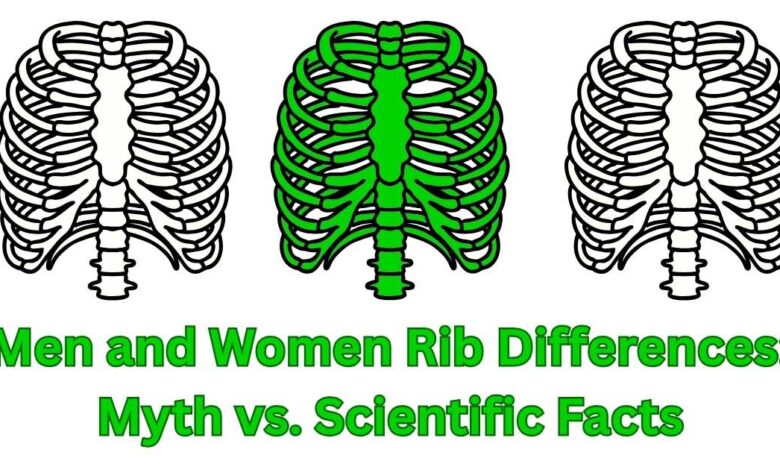Men and Women Rib Differences: Myth vs. Scientific Facts

For years, many have believed the story that men possess fewer ribs than women. This idea, often linked to religious texts such as the Bible,, where Eve was created from Adam’s rib, has been widely circulated. But does this belief hold any scientific weight? Let’s explore the anatomy of ribs and separate fact from fiction.
How Many Ribs Are Normal for Humans?
In general, both men and women have the same number of ribs—12 pairs, which totals 24 ribs. These ribs serve as a protective framework surrounding vital organs, such as the heart and lungs, and play a key role in the mechanics of breathing.
Important points to remember:
- Rib count does not differ based on gender.
- Ribs form the protective cage for vital organs.
- They assist in breathing by expanding and contracting the chest.
The Origins of the Rib Myth
The misconception that men have fewer ribs likely originates from the biblical narrative found in Genesis. In the story, Eve was fashioned from one of Adam’s ribs. Over time, this story was misunderstood, leading many to believe that men have fewer ribs than women. However, modern anatomical science clearly shows this is false.
Can Some People Have More or Fewer Ribs Than Usual?
While most people have 24 ribs, certain rare medical conditions can cause individuals to have either additional ribs or fewer ribs than the normal number. These anomalies are uncommon but medically recognized.
| Medical Condition | Description | Effect on Rib Count/Shape |
|---|---|---|
| Cervical Rib | Extra rib growing near the neck area | Presence of an additional rib |
| Down Syndrome | Genetic disorder affecting many systems | Occasional variations in rib number |
| Spondylocostal Dysplasia | Genetic disorder affecting spine and ribs | Rib fusion, malformation, or absence |
| Spondylothoracic Dysplasia | Severe abnormalities in spine and ribs | Deformed ribs leading to respiratory issues |
| Goldenhar Syndrome | Congenital disorder with multiple defects | Missing or malformed ribs |
Although these conditions can cause discomfort or complications, many people with such rib variations lead healthy lives.
Do Removed Ribs Regenerate?
Once a rib has been surgically removed, it does not grow back. The bone structure is permanent, though surrounding soft tissue and cartilage can heal after surgery. This information is crucial for those considering rib removal procedures.
Are There Differences in Ribcage Structure Between Genders?
While the number of ribs is identical in men and women, some structural differences exist:
- Women typically have slightly smaller ribcages than men.
- The angle of the ribs in women tends to be steeper, which may influence lung capacity and breathing dynamics.
These distinctions relate to shape and size rather than quantity.
What Are the Implications of Extra or Missing Ribs?
Extra ribs, like cervical ribs, can sometimes press on nearby nerves or blood vessels, potentially causing pain, numbness, or weakness in the arms. This condition, known as Thoracic Outlet Syndrome, may require medical intervention. Most individuals with such rib anomalies, however, experience no severe health issues.
How Do Ribs Assist with Breathing?
The ribs play an essential role in respiration:
- During inhalation, the ribcage moves outward and upward.
- This movement expands the chest cavity.
- The lungs fill with air, enabling oxygen exchange.
Any abnormality in the rib structure can affect breathing efficiency.
The Protective Function of the Ribcage
In addition to aiding respiration, the ribs protect critical organs, such as the heart and lungs. Their sturdy yet flexible structure shields these organs from injury while allowing necessary movement during breathing.
Frequently Asked Questions (FAQs)
A: No. Both men and women usually have 12 pairs of ribs, totaling 24.
A: Yes, but it’s rare and typically linked to specific medical conditions.
A: No, ribs do not regenerate once removed.
A: Yes. Women’s ribcages tend to be smaller, with ribs angled more sharply upward, but the rib count is the same.
A: Sometimes. Extra ribs may compress nerves or blood vessels, causing symptoms that may need treatment.
A: They expand the chest cavity during inhalation, allowing the lungs to fill with air.
Conclusion
In conclusion, the idea that men have fewer ribs than women is a myth without a scientific foundation. Both men and women have 24 ribs arranged in 12 pairs. Although rare conditions can alter the number or shape of ribs, these variations are not linked to gender and usually don’t cause serious health problems. Understanding these facts helps dispel a long-standing misconception and provides clearer insight into human anatomy.
